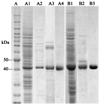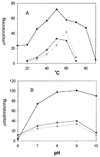Comparative characterization of Aedes 3-hydroxykynurenine transaminase/alanine glyoxylate transaminase and Drosophila serine pyruvate aminotransferase
- PMID: 12220660
- PMCID: PMC2857927
- DOI: 10.1016/s0014-5793(02)03229-5
Comparative characterization of Aedes 3-hydroxykynurenine transaminase/alanine glyoxylate transaminase and Drosophila serine pyruvate aminotransferase
Abstract
This study describes the comparative analysis of two insect recombinant aminotransferases, Aedes aegypti 3-hydroxykynurenine (3-HK) transaminase/alanine glyoxylate aminotransferase (Ae-HKT/AGT) and Drosophila melanogaster serine pyruvate aminotransferase (Dm-Spat), which share 52% identity in their amino acid sequences. Both enzymes showed AGT activity. In addition, Ae-HKT/AGT is also able to catalyze the transamination of 3-HK or kynurenine with glyoxylate, pyruvate or oxaloacetate as the amino acceptor. Kinetic analysis and other data suggest that Ae-HKT/AGT plays a critical role in mosquito tryptophan catabolism by detoxifying 3-HK and that Dm-Spat is primarily involved in glyoxylate detoxification.
Figures



Similar articles
-
Evolution of two alanine glyoxylate aminotransferases in mosquito.Biochem J. 2006 Aug 1;397(3):473-81. doi: 10.1042/BJ20060469. Biochem J. 2006. PMID: 16681462 Free PMC article.
-
3-Hydroxykynurenine transaminase identity with alanine glyoxylate transaminase. A probable detoxification protein in Aedes aegypti.J Biol Chem. 2002 May 3;277(18):15781-7. doi: 10.1074/jbc.M201202200. Epub 2002 Mar 5. J Biol Chem. 2002. PMID: 11880382
-
Crystal structures of Aedes aegypti alanine glyoxylate aminotransferase.J Biol Chem. 2006 Dec 1;281(48):37175-82. doi: 10.1074/jbc.M607032200. Epub 2006 Sep 21. J Biol Chem. 2006. PMID: 16990263
-
Energy-dependent degradation of a mutant serine: pyruvate/alanin: glyoxylate aminotransferase in a primary hyperoxaluria type 1 case.Adv Exp Med Biol. 1996;389:137-40. doi: 10.1007/978-1-4613-0335-0_16. Adv Exp Med Biol. 1996. PMID: 8861003 Review. No abstract available.
-
Liver peroxisomal alanine:glyoxylate aminotransferase and the effects of mutations associated with Primary Hyperoxaluria Type I: An overview.Biochim Biophys Acta. 2015 Sep;1854(9):1212-9. doi: 10.1016/j.bbapap.2014.12.029. Epub 2015 Jan 22. Biochim Biophys Acta. 2015. PMID: 25620715 Review.
Cited by
-
Fast and low-cost evaluation of hydroxykynurenine activity.MethodsX. 2020 Jul 2;7:100982. doi: 10.1016/j.mex.2020.100982. eCollection 2020. MethodsX. 2020. PMID: 32685382 Free PMC article.
-
Crystal structure of the Anopheles gambiae 3-hydroxykynurenine transaminase.Proc Natl Acad Sci U S A. 2006 Apr 11;103(15):5711-6. doi: 10.1073/pnas.0510233103. Epub 2006 Apr 3. Proc Natl Acad Sci U S A. 2006. PMID: 16585514 Free PMC article.
-
Cysteine and keto acids modulate mosquito kynurenine aminotransferase catalyzed kynurenic acid production.FEBS Lett. 2004 Nov 19;577(3):381-5. doi: 10.1016/j.febslet.2004.09.088. FEBS Lett. 2004. PMID: 15556614 Free PMC article.
-
A second generation of 1,2,4-oxadiazole derivatives with enhanced solubility for inhibition of 3-hydroxykynurenine transaminase (HKT) from Aedes aegypti.RSC Med Chem. 2020 Dec 9;12(2):222-236. doi: 10.1039/d0md00305k. eCollection 2021 Mar 4. RSC Med Chem. 2020. PMID: 34046611 Free PMC article.
-
Evolution of two alanine glyoxylate aminotransferases in mosquito.Biochem J. 2006 Aug 1;397(3):473-81. doi: 10.1042/BJ20060469. Biochem J. 2006. PMID: 16681462 Free PMC article.
References
-
- Li J, Li G. Insect. Biochem. Mol. Biol. 1997;27:859–867. - PubMed
-
- Han Q, Fang J, Li J. J. Biol. Chem. 2002;277:15781–15787. - PubMed
-
- Buchli R, Alberati-Giani D, Malherbe P, Kohler C, Broger C, Cesura AM. J. Biol. Chem. 1995;270:29330–29335. - PubMed
-
- Mosca M, Cozzi L, Breton J, Avanzi N, Toma S, Okuno E, Schwarcz R, Speciale C, Magagnin S, Mostardini M, Benatti L. Adv. Exp. Med. Biol. 1996;398:449–454. - PubMed
-
- Okuno E, Du F, Ishikawa T, Tsujimoto M, Nakamura M, Schwarcz R, Kido R. Brain Res. 1990;534:37–44. - PubMed
Publication types
MeSH terms
Substances
Grants and funding
LinkOut - more resources
Full Text Sources
Other Literature Sources
Molecular Biology Databases
Miscellaneous

